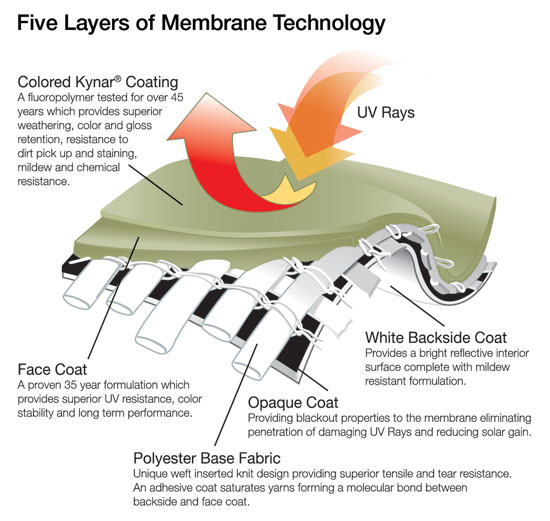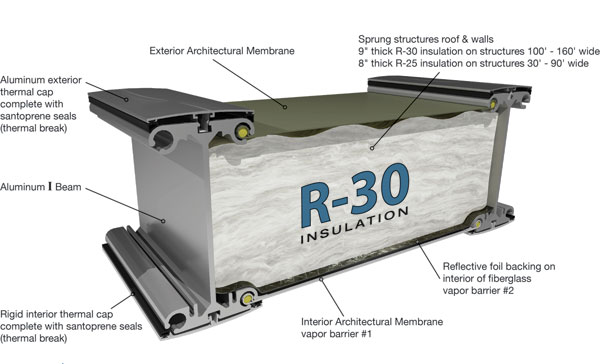Interim Executive Dining Facility Bridges Construction Gap at Business School
Today Kynar PVDF is widely accepted for superior long-term performance where color retention, weatherability, and low-maintenance reliability are required. In architectural membranes, Kynar PVDF extends membrane life, protecting the aesthetic appearance, improving cleanability, and offering exceptional fire-retardant capability. Kynar PVDF-coated membranes offer low maintenance and a clean, bright look that is conducive to graphic treatments.
Weighing approximately 24 ounces per square yard, a Kynar PVDF-coated fabric has a blackout design that prevents solar gain and manages climate control while guarding against UV and airborne contaminants. Color choice is also among the many hallmarks of the architectural membrane.
In addition to Kynar PVDF-coated fabric, Dupont Tedlar film is an excellent, highly versatile polyvinyl fluoride film (PVF) that when bonded to PVC membrane provides long-lasting protection against extreme weather, fading, cracking, and corroding.

Photo courtesy of Sprung Structures
Five layers of membrane technology make for an ultra strong material. As the accompanying illustration shows, these levels include a polyester base fabric, an opaque coat, a white backside coat, a face coat, and a colored fluoropolymer (Kynar) coating that provides superior weathering capability.
For shorter-term applications, acrylics are a good choice as a top finish on architectural membrane structures, too. The acrylics help to block the liquid modifiers from reaching the surface and inhibit dirt collection. Acrylic resins contain esters and incorporate other functional groups which are susceptible to photochemical degradation and hydrolysis, both of which are found in environmental exposure. These high-strength rip stop membranes are light weight, at approximately 18 ounces per square yard, and are opaque for maximum longevity and energy efficiency. They have superior fire retardant capability and their blackout design prevents solar gain and manages climate control. Many acrylic membranes are available in white, grey, or tan.
Some membranes are designed for extreme cold weather installations, with specialized low-temperature cold crack characteristics making an architectural membrane flexible for installation in extreme conditions of up to -60°F.
Insulation. Insulation performs better in an architectural membrane structure due to a number of reasons, not the least of which is the lack of differentiation between wall and roof, which means that a more consistent R-value rating is achieved throughout the entire building envelope. Unlike a metal building that compresses insulation at many locations within the finished product and lowers the R-value, an architectural membrane structure keeps the insulation much closer to its maximum thickness for optimal performance and comfort, reducing climate control costs. Consequently, the structure is ideally suited to almost any climate.
Some manufacturers, for example, utilize a double vapor barrier system eliminating mold and mildew, and a reflective foil backing doubles both as a vapor barrier and to retain and reflect radiant heat, adding to overall energy efficiency. The blanket itself can be as much as eight or nine inches thick, exceeding building code requirements. Further, the R-25 or R-30 rating of the fiberglass blanket contributes to an extremely energy-efficient system. In terms of sustainability issues, fiberglass has been certified by third-party testing to have a minimum recycled content of 25 percent, comprised of 20 percent post-consumer bottle glass and 5 percent post-industrial glass.
In addition, a membrane structure has up to five times the airtightness of a conventional building, further contributing to their surprising energy efficiency.
Benefits
Architectural membrane structures offer a host of benefits over conventional construction.
Design flexibility. Available in widths from 30 to 200 feet and in any length, fabric structures are quite versatile. They can often be butted up directly to a conventional building, or easily attached through a sealed connecting corridor system in widths up to more than 19 feet. As opposed to metal or other types of buildings which experience some limitations due to lower interior clear height, fabric structures have excellent clearspan views, making high ceilings easily achievable. Acoustically sensitive applications are suitable, too, as the curved profile of the structure creates an interior free from conventional flat walls and corners. The soft interior fabric walls effectively absorb sound, resulting in superior acoustic properties.
With a tall, column-free structure, design professionals and owners have the advantage of working in a flexible, open volume of space in which to install a unique and customized system of walls and other interior features. Light and space are accentuated in a fabric structure, too, as natural daylight infuses the area with a warm glow, high roofs create depth and roominess, and glazing walls add to the open and inviting characteristics of the building envelope. For additional daylight, a translucent daylight panel section can be specified as an integral part of the architectural membrane. Conventional glass curtain walls or glazing walls can be designed and engineered to integrate with the arched profile of a fabric structure.

Photo courtesy of Sprung Structures
Fabric structures allow for easy expansion or reduction over its service life, and can be dismantled, reconfigured, and re-erected for a number of applications. There are many color options, all of which are proven colorfast and weatherproof, and colors can generally be mixed and matched cost effectively by choosing a complementing wainscot.









